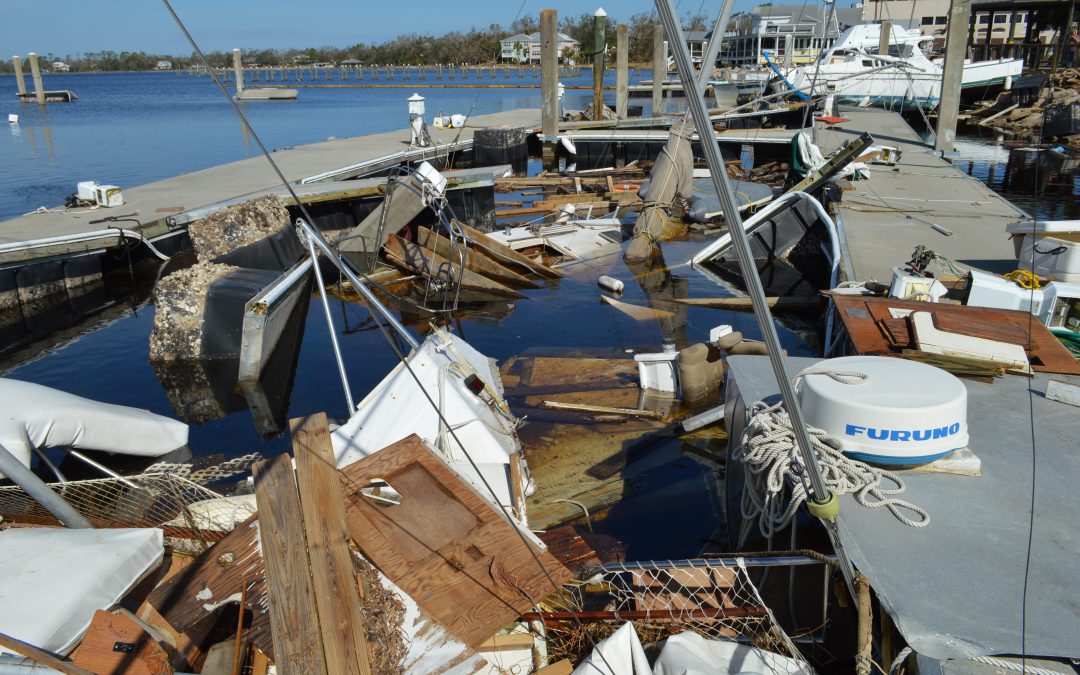
by Scott Jackson | Nov 26, 2018
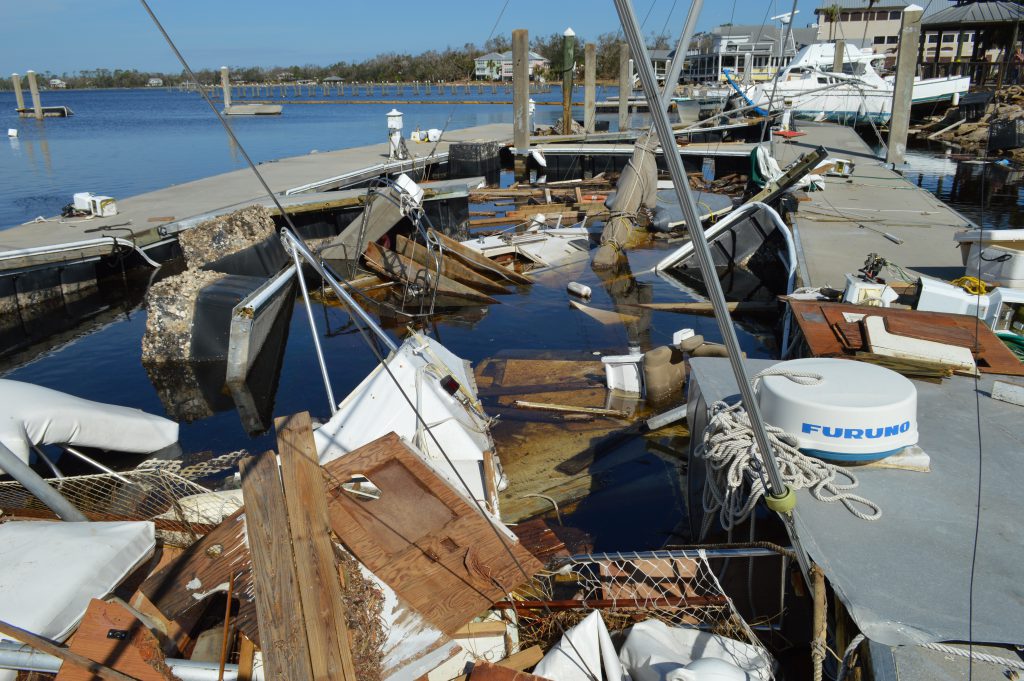
There was a special Fishery Disaster declaration post-Hurricane Michael. Here is an example of the damage to marinas and vessels that service our local fisheries. Unseen is the economic damage to fishing crews and supporting shore base businesses such as seafood processors, bait and tackle shops, and tourism related businesses. (Photo by Allen Golden).
Florida Governor Scott requested Fishery Disaster Assistance because of Hurricane Michael October 23, and the US Secretary of Commerce official responded with a determination letter providing additional disaster assistance to impacted fishing businesses and individuals October 31, 2018. https://www.commerce.gov/news/press-releases/2018/11/us-secretary-commerce-wilbur-ross-declares-fishery-disaster-florida
This link provides an outline for the established process to obtain Fishery Disaster Assistance: https://www.fisheries.noaa.gov/insight/frequent-questions-fishery-disaster-assistance
Additional Hurricane Michael relief funds and resources for local fisheries are welcome and encouraging. However, there are several steps before these specific program funds will be available. After the Secretary of Commerce sends the Florida Governor a determination letter, there are additional steps before those funds will reach the industry. The timing of these specific fisheries disaster resources varies; Hurricane Irma (2017) funds have not made it through the entire process at this time. A funding plan for Irma was recently developed by the state of Florida in September 2018. http://myfwc.com/conservation/special-initiatives/irma
Other disaster recovery programs, including those for Hurricane Michael, can be accessed now by fishing and coastal businesses. There is a helpful document written to help guide fishermen to other recovery resources with examples of how fishing businesses accessed some of these program funds. See more at https://www.fisheries.noaa.gov/webdam/download/66759294
One important immediate aid program to consider is the Florida Small Business Development Center ‘bridge” loan program. Solo proprietors can borrow $25,000 while businesses with paid employees can qualify for up to $50,000 for one year interest free. This program is meant to provide immediate dollars to assist business owners while they await other payments from insurance or federal assistance such as the Small Business Administration loan. Important Deadline: Applications will be accepted through December 7, 2018. Learn more about the Florida SBDC Bridge Loan program at http://www.floridadisasterloan.org
Federal Small Business Administration Disaster Loan Program is a long term loan to aid in business or personal recovery. https://disasterloan.sba.gov/ela/Documents/Three_Step_Process_SBA_Disaster_Loans.pdf
Business Recovery Centers (BRC) provide one on one counseling and assistance from both the Florida SBDC and US SBA to help individuals navigate the recovery process. The current location of the Hurricane Michael Business Recovery Centers is available at: http://floridasbdc.org/services/business-continuation/disaster/
The Florida SBDC also has permanent offices throughout Florida. Visit http://floridasbdc.org/locations/ to find a location near you.
If you need additional information assistance for your marina, commercial fishing, or for-hire charter business related to Hurricane Michael, please contact your local UF/IFAS Extension Office and Florida Sea Grant Extension Agent.
Bay County – Scott Jackson – LSJ@UFL.EDU
Gulf County – Ray Bodrey – RBODREY@UFL.EDU
Franklin and Wakulla Counties – Erik Lovestrand – ELOVESTRAND@UFL.EDU
Okaloosa and Walton Counties – Laura Tiu – LGTIU@UFL.EDU
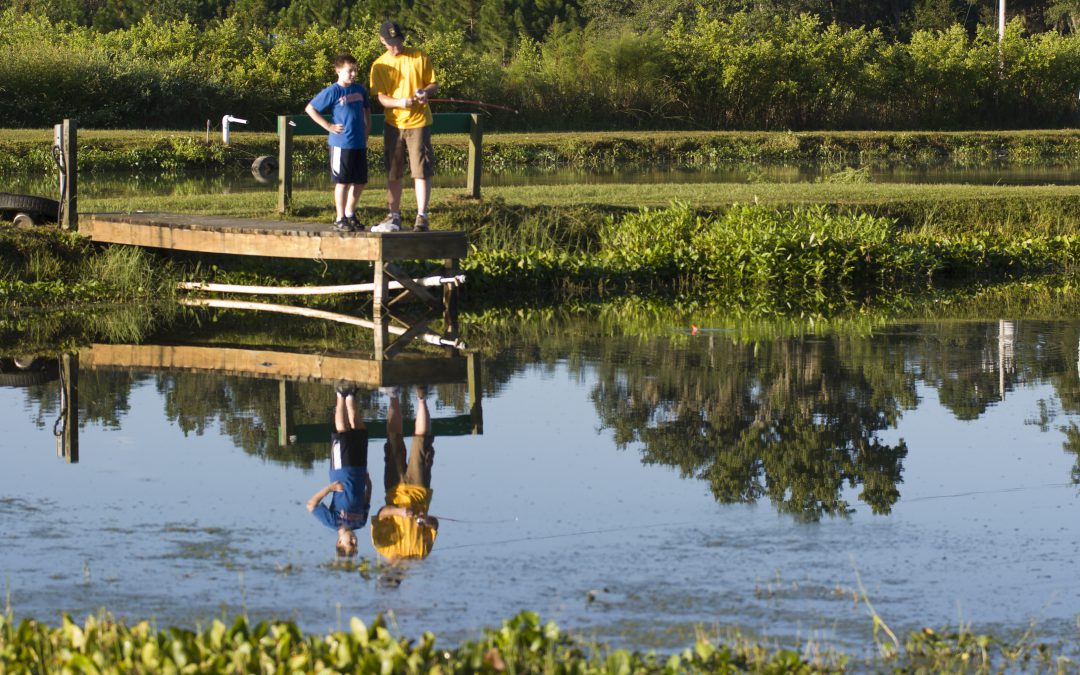
by Judy Biss | Nov 9, 2018
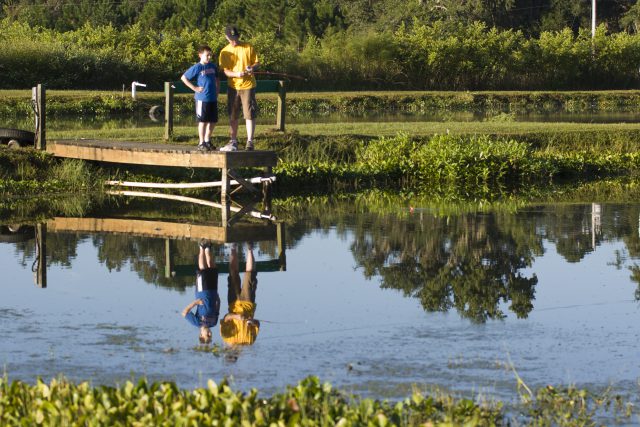
Farm ponds are used in a number of different ways, including fishing, irrigation, water control, and wildlife viewing. UF/IFAS Photo by Tyler Jones.
Farm ponds of all shapes and sizes are common in rural Northwest Florida. They are built for a number of reasons such as irrigation, water management, boating, fishing, wildlife viewing, livestock watering, and food production. Each of these uses guides the way the pond is managed to maintain its function, as well as its ecological beauty, but a factor that is important to all uses is having enough oxygen!
As you have probably observed, your pond is a dynamic system, which is influenced literally from the ground up! Much of the water’s basic chemical and physical characteristics reflect those of underlying soils (sand, clay, organic, etc.) and major sources of water (ground water, rainfall, runoff, etc.). The pond’s characteristics also influence how much oxygen is available for use by the plants and animals that live in it.
Why is Dissolved Oxygen and Aeration so Important?
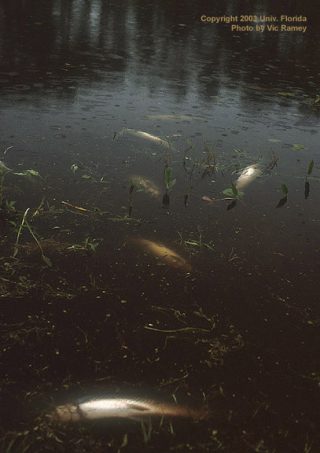
Fish kills are often the result of low dissolved oxygen levels and occur in both natural waters and man-made ponds. Photo by Vic Ramey.
The idea of oxygen being dissolved in water is a little counter-intuitive. Especially to us, as air-breathing humans! Think of your pond as a giant living, breathing organism. Its atmosphere is the water itself, and it contains dissolved oxygen gas for the fish, aquatic plants, insects, and zooplankton to “breathe.” Even bacteria need to breathe, and one of their fundamental roles in your pond is the decomposition of organic wastes like un-eaten fish food, and dead plant and animal materials.
Having enough dissolved oxygen in the water is one of the driving forces sustaining the health of your pond. Oxygen is dissolved into water directly from the atmosphere, wind and wave action, and by plant photosynthesis. Because warm water “holds” less dissolved oxygen than cold water, your pond’s dissolved oxygen levels can be lower in the summer than in the winter, especially in the early morning hours before plants begin to photosynthesize and produce oxygen. While longer days and warmer temperatures mean more sunlight for plants to photosynthesize and produce oxygen, the demand or need for oxygen by fish, bacteria, and other aquatic organisms is also increased. Periods of rainy, overcast days during the summer can greatly reduce oxygen production by plant photosynthesis. Combined that with the increased oxygen demand by other organisms, and dissolved oxygen levels can drop fast. These drops in dissolved oxygen levels often result in fish kills. Productive, nutrient-rich ponds with high levels of organic materials, and a high fish density are at a greater risk of the devastating effects of low dissolved oxygen levels.
What Can You Do to Insure Your Pond Has Enough Oxygen?
Do not be tempted to overfeed your fish. Feed them floating fish food so you can see how much they will consume in 10 to 15 minutes at each feeding. Consider feeding them every other day. In addition, as recommended in Managing Florida Ponds for Fishing “do not feed them when the water temperature is below 60° F, or, above 95° F. Fish do not actively feed at these times.” Use fish feeding behavior as your guide. Uneaten food will only add excess organic matter to the pond. The decomposition of this excess organic matter by bacteria increases the oxygen demand and likewise increases the chances of low oxygen levels and a fish kill.
Reduce nutrient inputs from runoff, livestock waste, excess fertilizer, and uneaten foods as described above, to help reduce the demand for oxygen in the system. Additionally, remove as much excess debris as possible that may have been blown into your pond as a result of October’s Hurricane Michael that affected much of Florida’s panhandle. Excess nutrients from these sources are freely available for use by hungry algae and other plants, which can then proliferate and, in turn, cause demand for more oxygen. This increased demand for oxygen can cause fish kills due to low oxygen levels as described above.
If you have an aerator, keep it operative especially during extended periods of cloudy and rainy weather. Watch your fish for signs of oxygen stress (not eating, remaining near and gulping at the surface) and aerate accordingly. Oxygen levels naturally fluctuate, and the lowest levels occur in the late evening through early morning hours when plants are not photosynthesizing and replenishing oxygen. Therefore, most important time to routinely operate the aerator is the late overnight hours into early morning.
If you don’t have an aerator, consider purchasing one, especially as your pond ages and grows more fish, plants, and algae. It is certainly less costly in the end to be proactive when it comes to maintaining adequate dissolved oxygen in your pond.
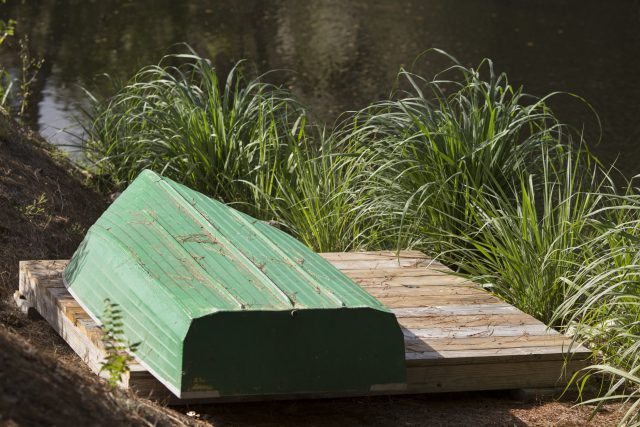
Recreation and fishing are important uses of many rural farm ponds. Photo by UF/IFAS Tyler Jones.
What kind of Aerator should I get?
There are a few basic aerator types. There are surface water agitators or fountains, and there are bottom air diffusers. They can be powered by electricity, wind, or solar power.
Diffuser aerators can help achieve a uniform oxygen distribution in your pond from top to bottom. This is especially important in deeper ponds (greater than 6-10 feet average depth) where temperature and oxygen stratification can occur. Diffuser aerators pump surface air through the base sitting on the bottom of the pond causing bubbles of air to rise to the surface. Diffusers also increase circulation and keep the deeper parts of your pond from becoming oxygen depleted. In a new pond, or one with flocculent sediments, a diffuser may cause turbidity due to the physical action of the diffuser base sitting on the pond bottom circulating oxygen from the bottom to the surface.
Other aerator options are the fountain sprays or surface agitators that aerate surface water. At a bare minimum, this can be a hose shooting water out over the water surface. Surface fountains and agitators work well in small shallow ponds, but are generally not recommended for larger more productive ponds that need more oxygen. In some commercial or farm ponds, paddle wheel agitators powered by a tractor’s pto are used during periods of low oxygen as an emergency measure when a fish kill is just beginning to occur.
Where Can I Purchase One?
The type or types of aerators you need for your pond will depend on the pond’s size, depth, level of productivity (nutrient level, number of fish), use, and water quality. There are a number of shopping options online for pond aerators. Try searching using the term “pond aerators Florida.” Also, some local Panhandle fingerling fish farms sell these products too. Here is a list of fish farms from the Florida Fish and Wildlife Conservation Commission: FWC Freshwater Fish Stocking List. Additionally, there are dissolved oxygen meters you can purchase which accurately read the amount of oxygen in your ponds. This is yet another tool to use in the overall management of your pond.

Simple surface agitators can be used to aerate small shallow ponds, but are generally not recommended for larger more productive ponds that need more oxygen. Photo by Judy Biss
More information about pond management can be found in the following references used for this article:
Overview of Florida Waters – Dissolved Oxygen
Clemson Cooperative Extension: Aeration, Circulation, and Fountains
Southern Regional Aquaculture Center: Pond Aeration
Managing Florida Ponds for Fishing
The Role of Aeration in Pond Management
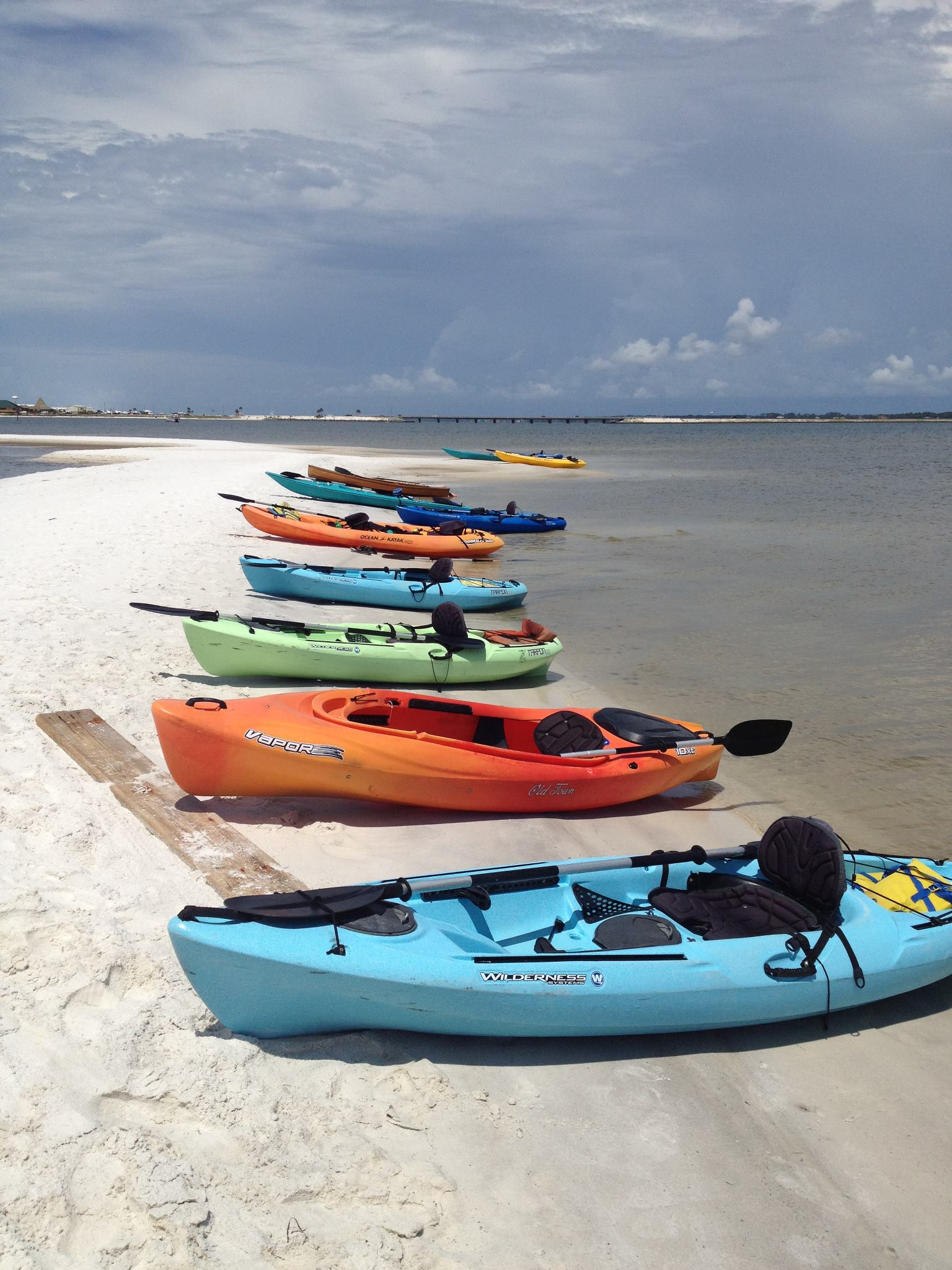
by Carrie Stevenson | Jun 17, 2017
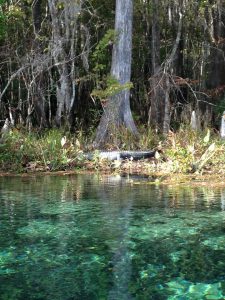
Wakulla Springs is home to some of the best wildlife watching in all of northwest Florida. It’s not unusual to see manatees, alligators, and dozens of species of birds in one boat trip. Photo credit: Carrie Stevenson
What do you imagine when the word “ecotourism” comes to mind? I know I usually daydream about a trip my husband I took to Costa Rica several years ago, surrounded by lush tropical rainforests as we ziplined through the canopy. I might also think about visiting a National Park, following a neatly maintained trail and stopping at signs placed at just the right spot so visitors can read and understand the special features of the place. Ecotourism, done right, brings a visitor to a unique place, tells its story, and immerses the visitor in the sights and sounds in a way that treads lightly on the location. I always know I’ve been on a good ecotour when I’m tired, happy, and have learned or seen something new.
A colleague with The Conservation Fund has stated that sustainable tourism includes: “Authentic experiences that are unique and specialized to the place (its culture, heritage, and natural resources), emphasizes quality over quantity, focuses on distinctive destinations, unspoiled landscapes, and historic buildings, and differs from mass-market tourism by favoring locally-owned businesses, thereby increasing circulation of money in the local economy.” The truly wonderful thing about ecotourism is that local touch; it exists solely because of the place, so it cannot be outsourced. The best storytellers about those places are usually the people who have lived there for many years, so by its very nature, ecotourism provides jobs for local residents.
Northwest Florida has hundreds of unique locations for visitors and locals to explore…we have centuries-old forts, clear-blue springs, endless rivers and creeks to paddle, trails on the coast and up our modest hills. We have caves and underground caverns, waterfalls, pitcher plant prairies, fishing, wildlife watching, and reefs for snorkeling and SCUBA diving. While millions come here for our quartz-sand beaches, other options that highlight our natural ecosystems deserve more attention and notoriety.
A few years ago, several Extension Agents received funding for a project called Naturally EscaRosa. The idea behind that project was to help promote and create businesses that sustainably used our agricultural and natural resources. The website (www.naturallyescarosa.com) has a list of over 100 businesses and locations where locals and out-of-town visitors can explore the less well-traveled areas of Escambia and Santa Rosa County. As you move east down the coast, Walton Outdoors, the local Visit Florida affiliates, and other privately managed media groups have done similar work, providing a showcase for these treasures in our midst.
This summer, try one of the local ecotourism or agritourism venues near you! Moreover, when your friends and family visit from out of town, encourage them to do the same. We cannot have a successful economy without a healthy ecosystem, and supporting these local and regional businesses is good for both.
For more information on sustainable ecotourism, visit the Society for Ethical Ecotourism (SEE), and for information on starting or visiting an agritourism business, try Visit Florida Farms. And as always, reach out to your local County Extension agents, and we will be more than happy to point you in the right direction to discover to places to explore with your family.
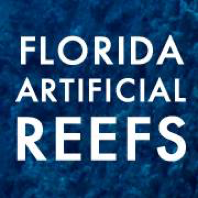
by Scott Jackson | Feb 16, 2017
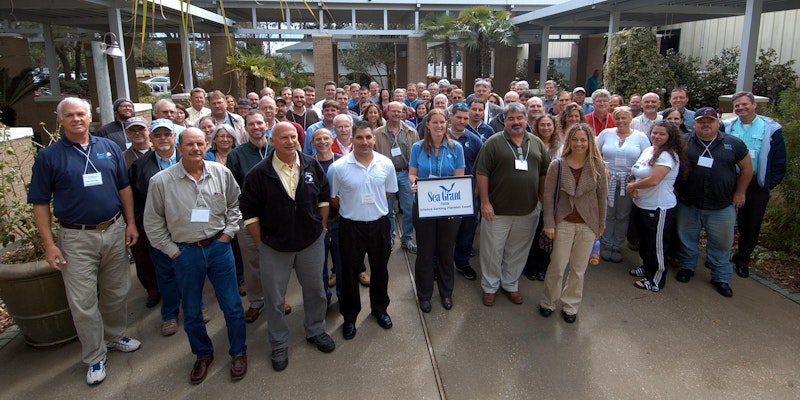
Northwest Florida Workshop Attendees from 2013 in Niceville, FL. This year’s workshop will be held at the UF/IFAS Extension Okaloosa County Office in Crestview, February 22, 2017. Direction and Contact Information can be found at this link http://directory.ifas.ufl.edu/Dir/searchdir?pageID=2&uid=A56
Researchers from University of West Florida recently estimated the value of Artificial Reefs to Florida’s coastal economy. Bay County artificial reefs provide 49.02 million dollars annually in personal income to local residents. Bay County ranks 8th in the state of Florida with 1,936 fishing and diving jobs. This important economic study gives updated guidance and insight for industry and government leaders. This same level of detailed insight is available for other Northwest Florida counties and counties throughout the state.
The UWF research team is one of several contributors scheduled to present at the Northwest Florida Artificial Reef Manager’s Workshop February 22. Florida Fish and Wildlife Commission and Florida Sea Grant are hosting the workshop. This meeting will bring together about fifty artificial reef managers, scientists, fishing and diving charter businesses, and others interested in artificial reefs to discuss new research, statewide initiatives and regional updates for Florida’s Northwest region. The meeting will be held at the UF/IFAS Extension Okaloosa County Office in Crestview, FL.
Cost is $15.00 and includes conference handouts, light continental breakfast with coffee, lunch, and afternoon refreshments. Register now by visiting Eventbrite or short link url https://goo.gl/VOLYkJ.
A limited number of exhibit tables/spaces will be available. For more information, please contact Laura Tiu, lgtiu@ufl.edu or 850-612-6197.
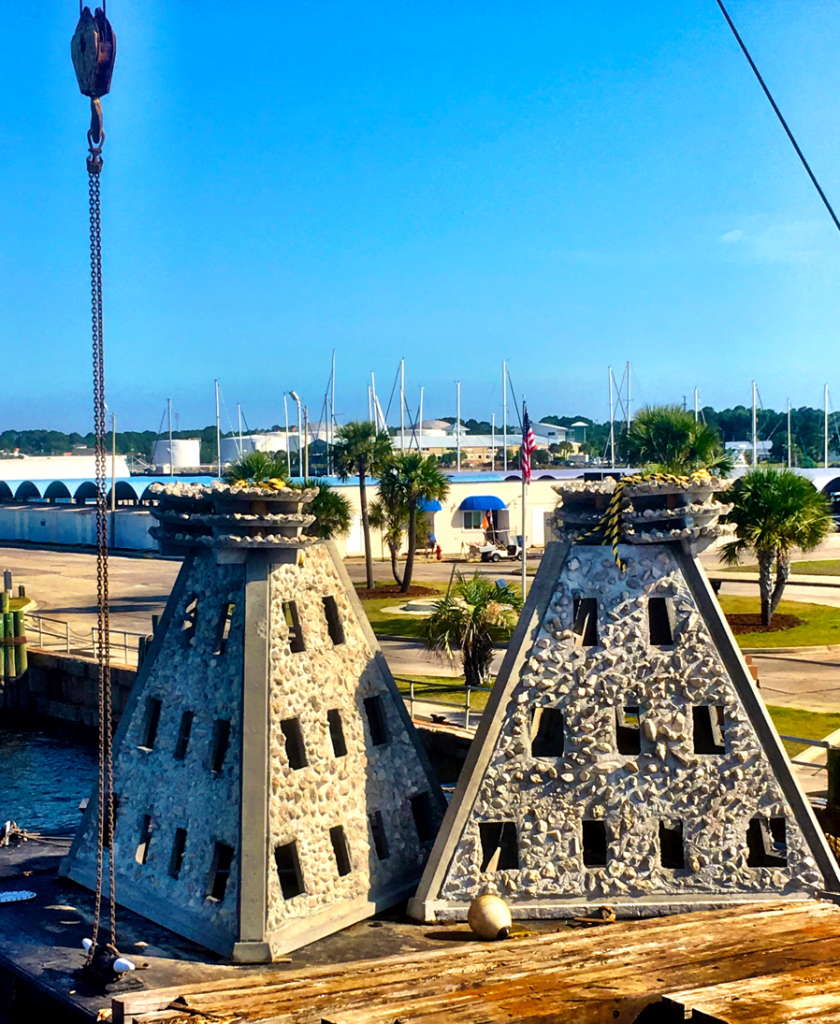
Super Reefs staged at the Panama City Marina, which were deployed in SAARS D, located 3 nautical miles south of Pier Park. Learn more about this reef project and others at the Northwest Florida Artificial Reef Manager’s Workshop in Crestview, February 22, 2017. (Photo by Scott Jackson).
Northwest Florida Artificial Reef Workshop Tentative Agenda
Date: February 22, 2017
Where: UF/IFAS Extension Okaloosa County Office, 3098 Airport Road Crestview, FL 32539
8:15 Meet and Greet
9:00 Welcome and Introductions – Laura Tiu UF/IFAS Okaloosa Co and Keith Mille, FWC
9:25 Regional and National Artificial Reef Updates – Keith Mille
9:50 Invasive Lionfish Trends, Impacts, and Potential Mitigation on Panhandle Artificial Reefs – Kristen Dahl, University of Florida
10:20 Valuing Artificial Reefs in Northwest Florida – Bill Huth, University of West Florida
11:00 County Updates – Representatives will provide a brief overview of recent activities 12:00 LUNCH (included with registration)
12:00 LUNCH
1:00 NRDA NW Florida Artificial Reef Creation and Restoration Project Update – Alex Fogg, FWC
1:15 Goliath Grouper Preferences for Artificial Reefs: An Opportunity for Citizen Science – Angela Collins, FL, Sea Grant
1:45 Current Research and Perspectives on Artificial Reefs and Fisheries – Will Patterson, University of Florida
3:00 BREAK
3:30 Association between Habitat Quantity and Quality and Exploited Reef Fishes: Implications for Retrospective Analyses and Future Survey Improvements – Sean Keenan, FWRI
3:50 Innovations in Artificial Reef Design and Use – Robert Turpin, facilitator
4:10 Using Websites and Social Media to Promote Artificial Reef Program Engagement – Bob Cox, Mexico Beach Artificial Reef Association & Scott Jackson, UF/IFAS Bay Co
4:40 Wrap Up and Next Steps – Keith Mille and Scott Jackson
5:00 Adjourn and Networking
Register now by visiting Eventbrite or short link url https://goo.gl/VOLYkJ. Live Broadcast, workshop videos, and other information will be available on Facebook at https://www.facebook.com/floridaartificialreefs/ (Florida Artificial Reefs) .

An Equal Opportunity Institution. University of Florida, Institute of Food and Agricultural Sciences (UF/IFAS) Extension, Nick T. Place, Dean.
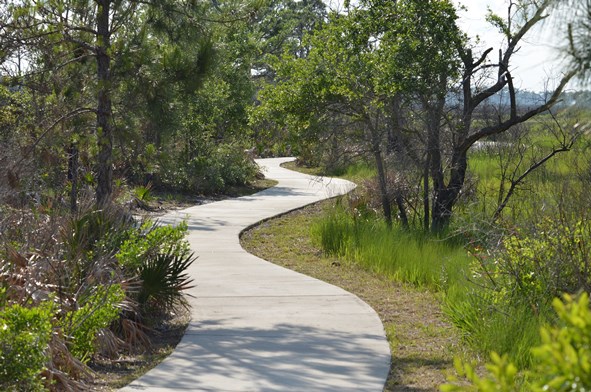
by Les Harrison | Jan 8, 2017
Some of the most picturesque and scenic natural areas along north Florida’s Gulf Coast are found in Bald Point State Park. The 4,065 acre park is located on Alligator Point, where Ochlockonee Bay meets Apalachee Bay.
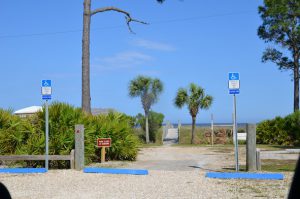
Easy access to water activities at Bald Point State Park.
Photo: Les Harrison
Bald Point State Park offers a variety of land and water activities. Coastal marshes, pine flatwoods, and oak thickets foster a diversity of biological communities which make the park a popular destination for birding and wildlife viewing.
These include shorebirds along the beach, warblers in the maritime oak hammocks, wading birds, and birds of prey in and around the marsh areas. The boardwalk and observation deck overlook the marsh near the beach.
During autumn bald eagles and other migrating raptors, along with monarch butterflies are frequently viewed heading south to a warmer winter.
Bald Point offers access to two Apalachee Bay beaches for water sports and leisure activities, and these facilities include a fishing dock and picnic pavilions at Sunrise beach, North End beach and Maritime Hammock beach. Grills and restrooms are also available, but pets are prohibited on the beach.
Pre-Columbian pottery helped archaeologists identify the park’s oldest site, placing the earliest human activity 4,000 years ago. These early inhabitants hunted, fished, collected clams and oysters, and lived in relatively permanent settlements provided by the abundant resources of the coast and forests.
In the mid-1800s and late 1900s, fishermen established seineyards at Bald Point. These usually primitive campsites included racks to hang, dry and repair nets. Evidence of the 19th to 20th century turpentine industry is visible on larger pine trees cut with obvious scars.
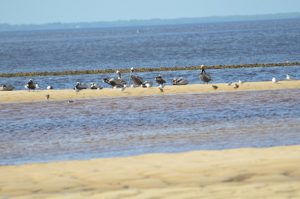
Bald Point is an excellent location for both wildlife viewing and birding.
Photo: Les Harrison
Among the varieties of saltwater fish found in the brackish tidal waterway are redfish, trout, flounder and mackerel.
Today’s visitors may fish on the bridge over tidal Chaires Creek off of Range Road, and in Tucker Lake, by canoe or kayak. Sea trout, red fish, flounder and sheepshead are common catches, and this is an excellent area to cast net for mullet or to catch blue crabs.
Bald Point State Park is open 8:00 a.m. to sunset daily, with a charge $4.00 per car with up to eight people, or $2.00 per pedestrian or bicycle
More information is available at the Florida State Park site.

There are numerous trails where the visitor and explore Florida.
Photo: Les Harrison.
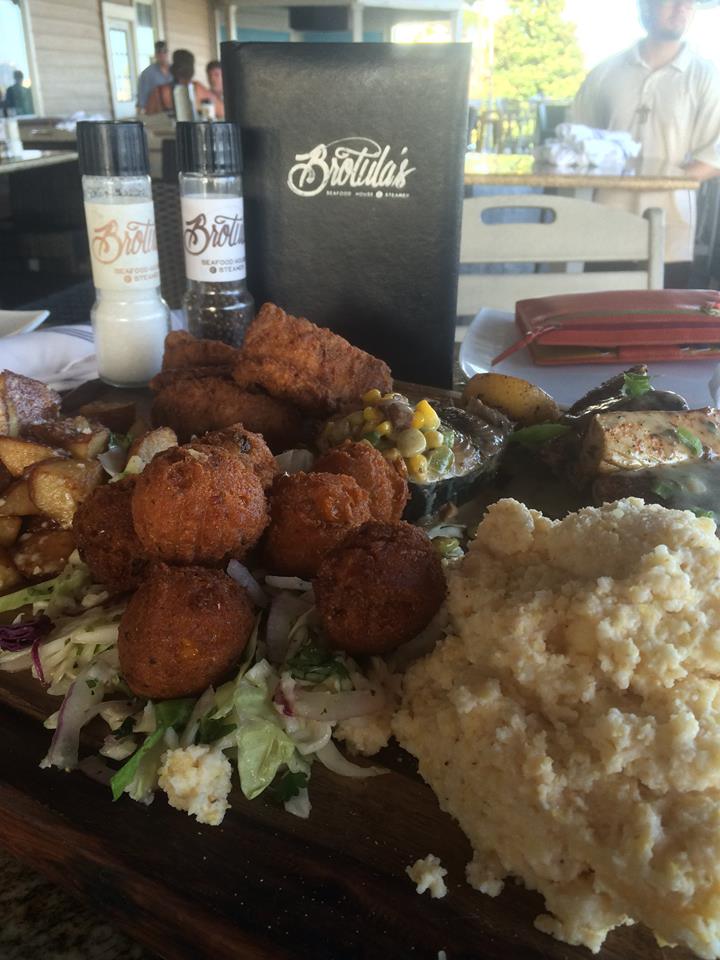
by Laura Tiu | Oct 7, 2016
I’ve spent the past 25 years studying and growing fish. When folks find out I’m a fish head, I often get a lot of questions about the safety and sustainability of many seafood products. It seems that the media and other groups have done a good job of scaring and confusing the American public to the point that some forgo consuming seafood altogether. That is such a shame because seafood is great for human health. Seafood is typically high protein, low in fat and calories and bursting with good for you stuff like omega-3s.
Seafood is either wild caught, aquacultured (farm-raised), or both. Both wild fisheries and aquaculture have their pros and cons. Overfishing, illegal fishing, bycatch, habitat degradation and lack of effective regulation have led to declines in wild fisheries. Aquaculture has been plagued with claims of pollution, disease and escapees. With all this negative press, what is the consumer to do?
You can choose your seafood based on its sustainability. Sustainable seafood has been caught or farmed in sustainable ways. And there are several groups today that make choosing these sustainable product easy. Once such group is the Monterrey Bay Aquarium. Their Seafood Watch program makes it easy for you to choose seafood that’s fished or farmed in ways that have less impact on the environment.
Using science-based criteria and input from fisheries and aquaculture experts, Seafood Watch has developed standards and guiding principles to develop consumer friendly guides. The guides are specific to each state and there is even one for sushi. These printable guides fit easily into your wallet so that you can use them anytime you purchase seafood. The guide shows with seafood items are “Best Choices” or “Good Alternatives,” and which ones you should “Avoid.” They also have an app for android and IPhone making it easier than ever to get the latest recommendations for seafood and sushi, learn more about the seafood you eat, and locate or share businesses that serve sustainable seafood.
As consumers, we have a lot of power in the seafood marketplace. With over 75% of the world’s fisheries either fully fished or overfished, we need to make smart choices about the seafood we buy and consume. By supporting fisheries and fish farms that are working hard to limit their impact on the environment we help protect the seafood we love. By using the seafood guide for your region, you’re making choices based on the best available information and supporting environmentally friendly fisheries and aquaculture operations.
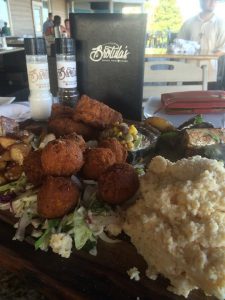
Brotula’s Restaurant in Destin, Florida will cook your fresh catch to perfection.


















